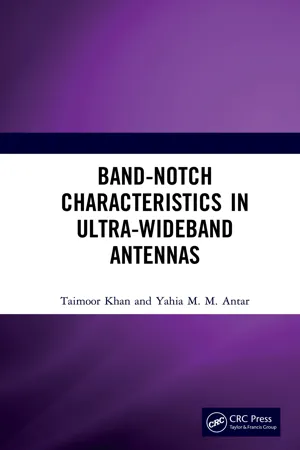
- 168 pages
- English
- ePUB (mobile friendly)
- Available on iOS & Android
Band-Notch Characteristics in Ultra-Wideband Antennas
About this book
This book comprehensively reviews ultra-wideband (UWB) and UWB multi-input multi-output (MIMO) antennas with band-notched characteristics, with a focus on interference cancellation functionality. The book is organized into seven chapters that cover single band, dual band, and multi band-notched UWB antennas, followed by band-notched characteristics in UWB (MIMO) antennas. Further, it explains the mechanism of reconfigurability and tunability in band-notched UWB antennas, including advanced applications of UWB systems. Overall, it covers different techniques of canceling the electromagnetic interference in UWB in a concise volume.
Features
- Provides a comprehensive presentation of avoiding interference in UWB systems
- Reviews state of the art literature related to UWB antennas, filtennas, and various reconfigurable technologies
- Explains different techniques for producing band-notch characteristics in UWB systems
- Includes discussion on historical perspectives of UWB technology
- Consolidates different research activities carried out on the electromagnetic interference cancellation techniques in the UWB communication systems
Band-Notch Characteristics in Ultra-Wideband Antennas is aimed at researchers and graduate students in electrical and antenna engineering.
Taimoor Khan has been an Assistant Professor at the Department of Electronics and Communication Engineering, National Institute of Technology Silchar since 2014. In addition to this, Dr. Khan has also worked as a Visiting Assistant Professor at Asian Institute of Technology Bangkok, Thailand during September–December, 2016. His active research interests include Printed Microwave Circuits, Electromagnetic Bandgap Structures, Ultra-wideband Antennas, Dielectric Resonator Antennas, Ambient Microwave Energy Harvesting, and Artificial Intelligence Paradigms in Electromagnetics. Dr. Khan has successfully guided three Ph.D. theses, and is supervising six Ph.D. students. He has published over 75 research articles in well-indexed journals and in world-renowned conference proceedings. Currently, he is executing three funded research projects, including two international collaborative SPARC and VAJRA research projects. In September 2020, Dr. Khan has been awarded a prestigious national IETE-Prof SVC Aiya Memorial Award for the year 2020.
Yahia M. M. Antar has been a Professor at the Department of Electrical and Computer Engineering, Royal Military College of Canada since 1990. He served as the Chair of CNC, URSI from 1999 to 2008, Commission B from 1993 to 1999, and has a cross appointment at Queen's University in Kingston. He has authored and co-authored over 250 journal papers, several books and chapters in books, over 500 refereed conference papers, holds several patents, has chaired several national and international conferences, and has given plenary talks at many conferences. Dr. Antar is a fellow of the Engineering Institute of Canada, the Electromagnetic Academy, and an International Union of Radio Science (URSI). He was elected by the URSI to the Board as the Vice President in 2008 and in 2014, and to the IEEE AP AdCom in 2009. In 2011, he was appointed as a member of the Canadian Defence Advisory Board (DAB) of the Canadian Department of National Defence. He serves as an Associate Editor for many IEEE and IET Journals, and as an IEEE-APS Distinguished Lecturer. Presently, he is working as President-Elect for IEEE Antenna and Propagation Society for the year 2020.
Frequently asked questions
- Essential is ideal for learners and professionals who enjoy exploring a wide range of subjects. Access the Essential Library with 800,000+ trusted titles and best-sellers across business, personal growth, and the humanities. Includes unlimited reading time and Standard Read Aloud voice.
- Complete: Perfect for advanced learners and researchers needing full, unrestricted access. Unlock 1.4M+ books across hundreds of subjects, including academic and specialized titles. The Complete Plan also includes advanced features like Premium Read Aloud and Research Assistant.
Please note we cannot support devices running on iOS 13 and Android 7 or earlier. Learn more about using the app.
Information
1
Band-Notched UWB Antennas
1.1 Introduction
1.2 Concept of Band-Notched Filtering in UWB Antennas


1.3 Single Band-Notched Characteristics
Table of contents
- Cover
- Half Title
- Title Page
- Copyright Page
- Contents
- List of Figures
- List of Tables
- Preface
- Acknowledgement
- 1 Band-Notched UWB Antennas
- 2 Single Band-Notched UWB Antennas
- 3 Dual Band-Notched UWB Antennas
- 4 Multi Band-Notched UWB Antennas
- 5 Band-Notched UWB MIMO Antennas
- 6 Reconfigurable Band-Notched UWB Antennas
- 7 Tunable Band-Notched UWB Antennas
- Index